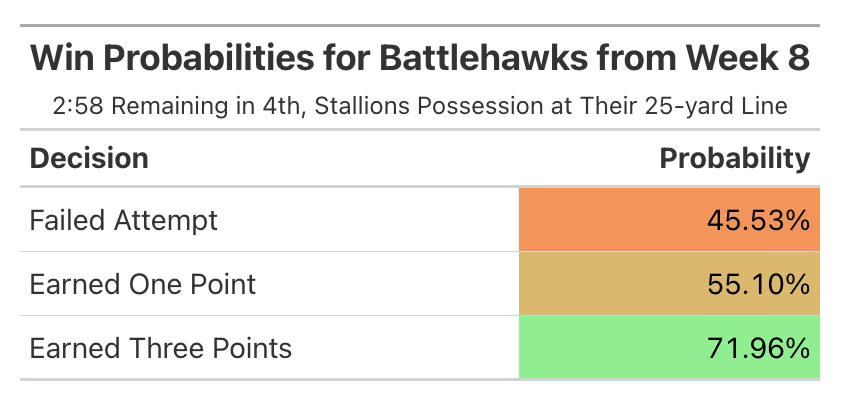In one of the more exciting and impact games of the 2025 UFL season, St. Louis Battlehawk running back Jacob Saylors scored a game-tying touchdown with 3:03 remaining in regulation. Head coach Anthony Becht then had an important decision to make: go for one to take the lead or go for three to where an opposing field goal does not beat you. Becht opted for one, Saylors found paydirt again and the Battlehawks wound up winning by one1.
For those who need a refresher, in the UFL, there are no kicks after a touchdown. An offense earns one attempt for more points and can go for one from the 2-yard line, two from the 5-yard line or three from the 10-yard line. One of the tools I will be using a lot in this piece is the win probability calculator from Pro Football Reference. Without getting into much of the statistical theory behind it, the tool allows you to adjust a variety of factors to determine the win probability a team has at that point in a football game.
Though we are dealing with UFL offenses and not NFL offenses, what we can do is look at the likelihood a team will score based upon what is decided after a touchdown between two evenly matched teams:
These probabilities only exist in a vacuum, many other factors should be considered such as team strength, score and time remaining in the game. It’s why this argument alone does not suffice when recommending what the Battlehawks should have done. Fortunately, our PFR tool can give us a better indicator as far as where they stood given various outcomes AND given the Battlehawks were 1.5-point favorites at last check:
Though St. Louis would be at a disadvantage by not coming away with points, the trade-off seems to be worth it by going for three.
St. Louis isn’t the only team apprehensive of going for three. Through eight weeks, half of the league has not even attempted such a play; and often, those who have tried only do so out of necessity, not because it would make the most statistical sense like the aforementioned example. However, if your risk-seeking blood is boiling, take comfort knowing nearly twice as many two-point tries (95) have been attempted than one-point tries (58). Leading the way in this aggressiveness is Arlington:
Shown here are the number of successful attempts by each team. Interestingly, Birmingham has attempted the same number of two-point tries as Arlington, it’s just that the Renegades have been way better at them, showcasing why Luis Perez and company have one of the more dangerous offenses in the league. Still, the team that can master attempting more threes and making more of them may find an edge.
While the rest of league may be engaging in groupthink, there is one more important observation from the chart worth exploring: until last week, Michigan boasted the best quarterback in the UFL this season in Bryce Perkins, yet, Mike Nolan still goes for one more than twice as often as any other team. At some point, that conservatism could spell disaster. Birmingham will be hosting Michigan in the playoffs in a few weeks, so this weekend’s game may be tougher to predict, but at some point the Stallions will be scoring more and converting more attempts. I’m backing Birmingham -2.5 on FanDuel.
St. Louis was favored by 1.5 so my advice last week did not pan out. My apologies. I was even more animated during a losing a bet than usual, FWIW.






